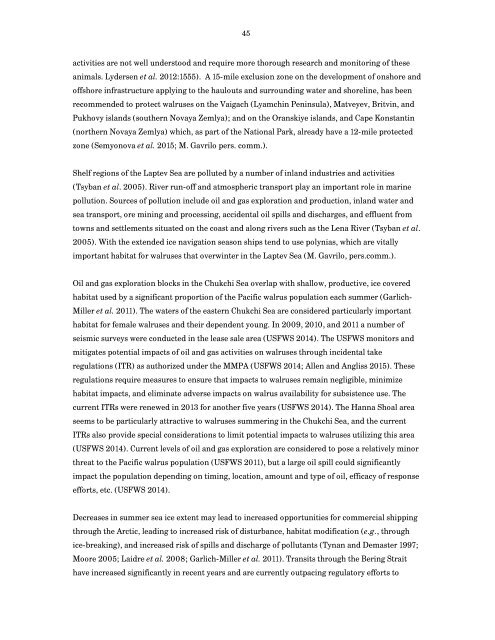The State of Circumpolar Walrus Populations
walrusreport
walrusreport
Create successful ePaper yourself
Turn your PDF publications into a flip-book with our unique Google optimized e-Paper software.
45<br />
activities are not well understood and require more thorough research and monitoring <strong>of</strong> these<br />
animals. Lydersen et al. 2012:1555). A 15-mile exclusion zone on the development <strong>of</strong> onshore and<br />
<strong>of</strong>fshore infrastructure applying to the haulouts and surrounding water and shoreline, has been<br />
recommended to protect walruses on the Vaigach (Lyamchin Peninsula), Matveyev, Britvin, and<br />
Pukhovy islands (southern Novaya Zemlya); and on the Oranskiye islands, and Cape Konstantin<br />
(northern Novaya Zemlya) which, as part <strong>of</strong> the National Park, already have a 12-mile protected<br />
zone (Semyonova et al. 2015; M. Gavrilo pers. comm.).<br />
Shelf regions <strong>of</strong> the Laptev Sea are polluted by a number <strong>of</strong> inland industries and activities<br />
(Tsyban et al. 2005). River run-<strong>of</strong>f and atmospheric transport play an important role in marine<br />
pollution. Sources <strong>of</strong> pollution include oil and gas exploration and production, inland water and<br />
sea transport, ore mining and processing, accidental oil spills and discharges, and effluent from<br />
towns and settlements situated on the coast and along rivers such as the Lena River (Tsyban et al.<br />
2005). With the extended ice navigation season ships tend to use polynias, which are vitally<br />
important habitat for walruses that overwinter in the Laptev Sea (M. Gavrilo, pers.comm.).<br />
Oil and gas exploration blocks in the Chukchi Sea overlap with shallow, productive, ice covered<br />
habitat used by a significant proportion <strong>of</strong> the Pacific walrus population each summer (Garlich-<br />
Miller et al. 2011). <strong>The</strong> waters <strong>of</strong> the eastern Chukchi Sea are considered particularly important<br />
habitat for female walruses and their dependent young. In 2009, 2010, and 2011 a number <strong>of</strong><br />
seismic surveys were conducted in the lease sale area (USFWS 2014). <strong>The</strong> USFWS monitors and<br />
mitigates potential impacts <strong>of</strong> oil and gas activities on walruses through incidental take<br />
regulations (ITR) as authorized under the MMPA (USFWS 2014; Allen and Angliss 2015). <strong>The</strong>se<br />
regulations require measures to ensure that impacts to walruses remain negligible, minimize<br />
habitat impacts, and eliminate adverse impacts on walrus availability for subsistence use. <strong>The</strong><br />
current ITRs were renewed in 2013 for another five years (USFWS 2014). <strong>The</strong> Hanna Shoal area<br />
seems to be particularly attractive to walruses summering in the Chukchi Sea, and the current<br />
ITRs also provide special considerations to limit potential impacts to walruses utilizing this area<br />
(USFWS 2014). Current levels <strong>of</strong> oil and gas exploration are considered to pose a relatively minor<br />
threat to the Pacific walrus population (USFWS 2011), but a large oil spill could significantly<br />
impact the population depending on timing, location, amount and type <strong>of</strong> oil, efficacy <strong>of</strong> response<br />
efforts, etc. (USFWS 2014).<br />
Decreases in summer sea ice extent may lead to increased opportunities for commercial shipping<br />
through the Arctic, leading to increased risk <strong>of</strong> disturbance, habitat modification (e.g., through<br />
ice-breaking), and increased risk <strong>of</strong> spills and discharge <strong>of</strong> pollutants (Tynan and Demaster 1997;<br />
Moore 2005; Laidre et al. 2008; Garlich-Miller et al. 2011). Transits through the Bering Strait<br />
have increased significantly in recent years and are currently outpacing regulatory efforts to


